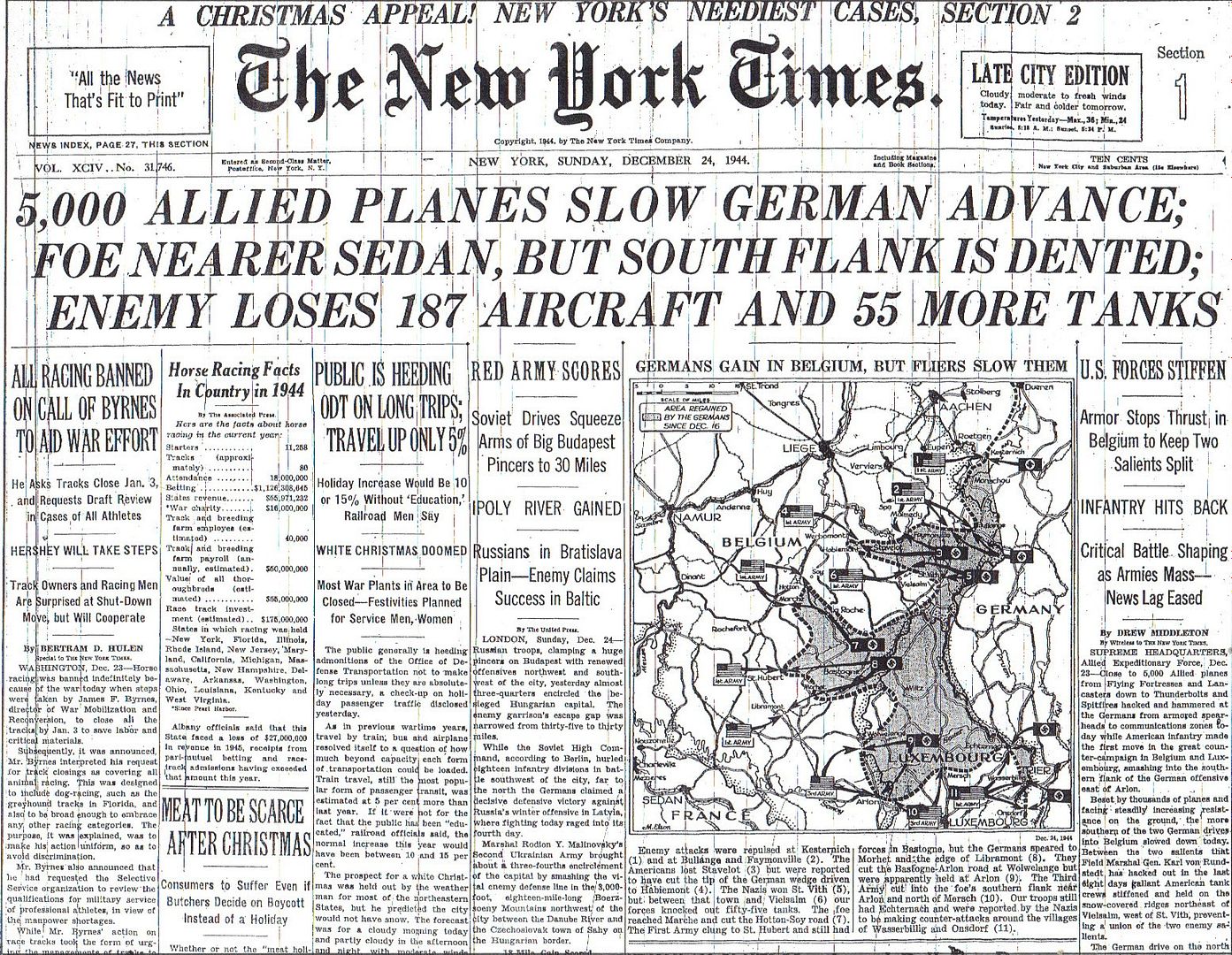
Posted on 12/24/2014 4:46:51 AM PST by Homer_J_Simpson

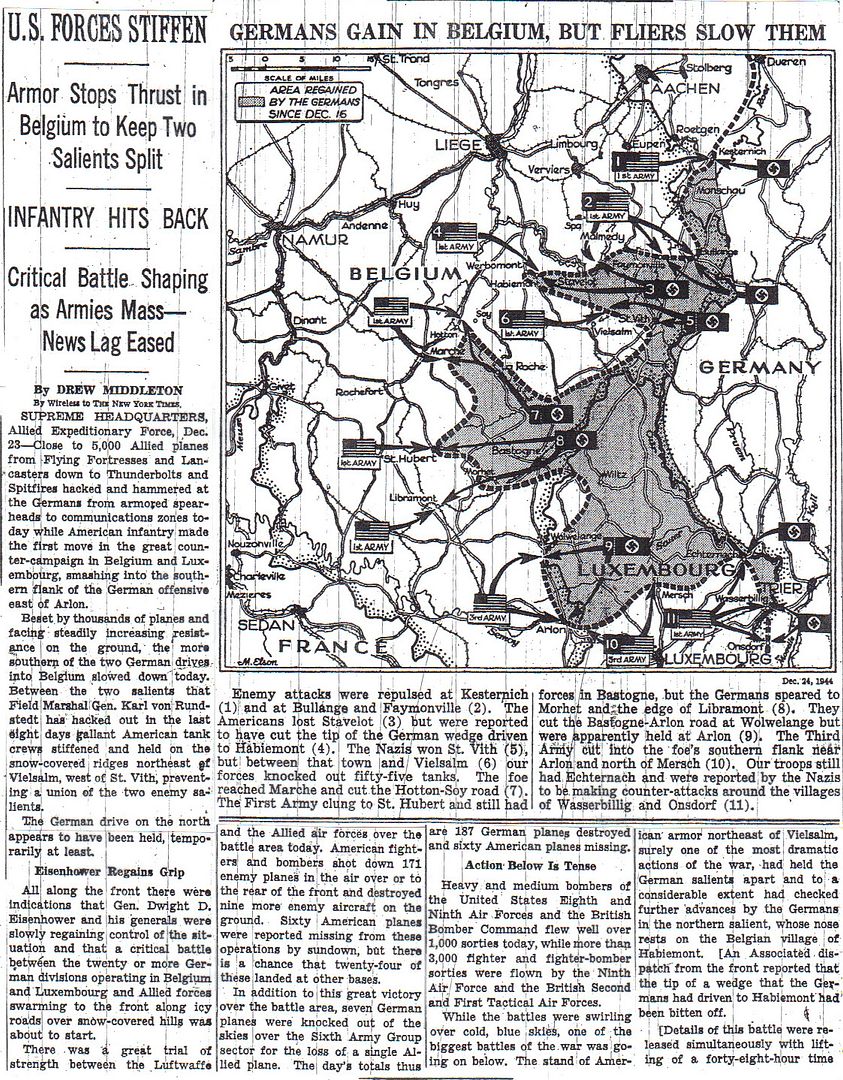
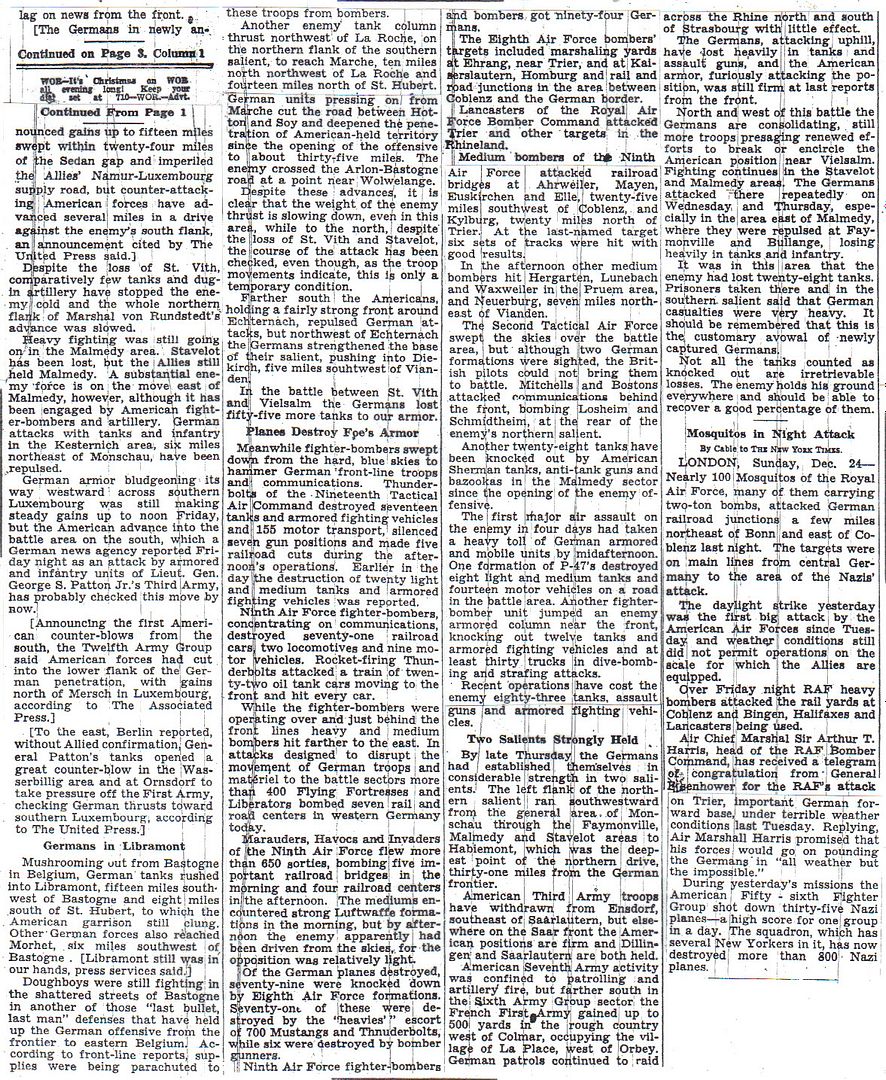
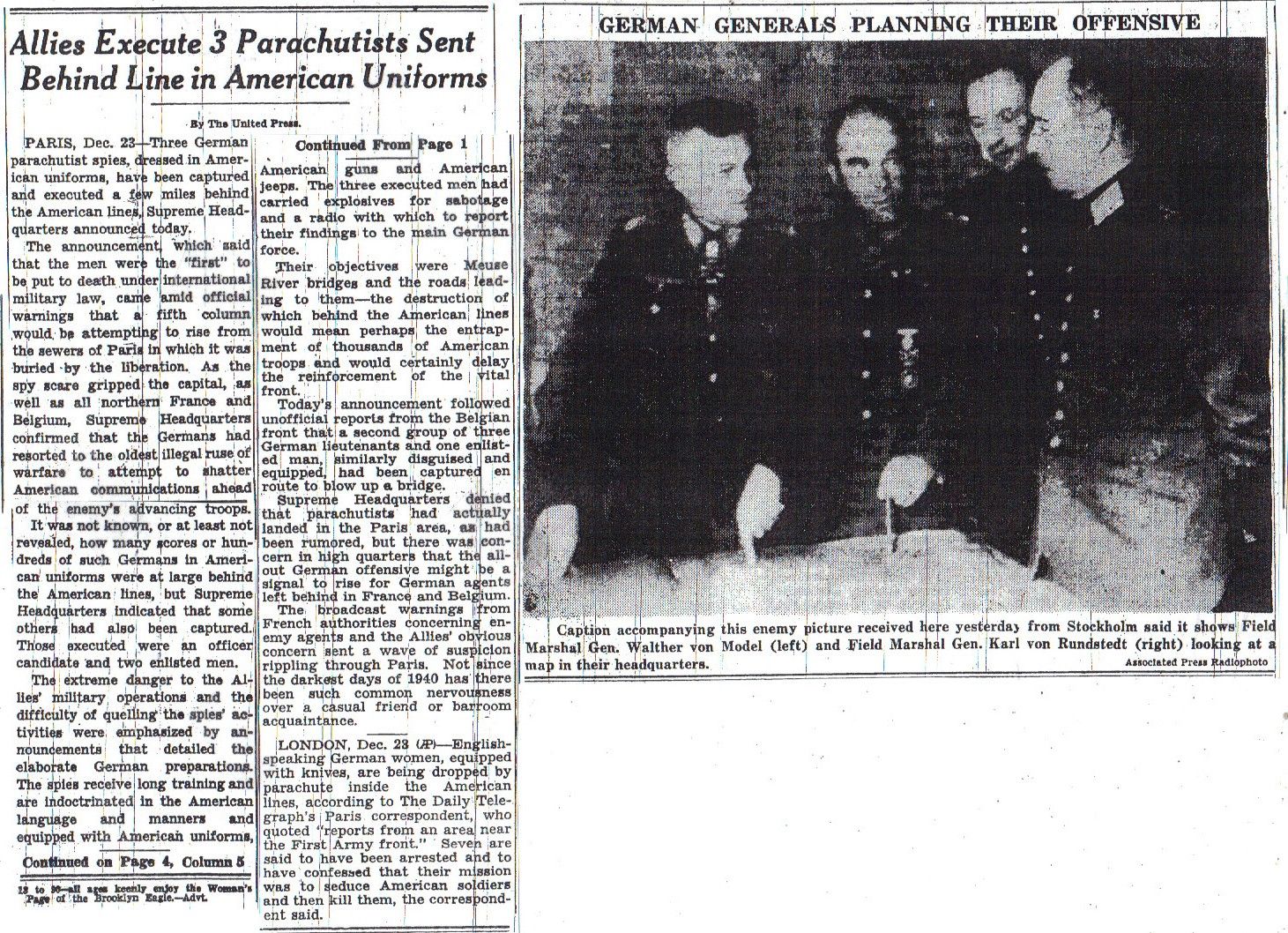
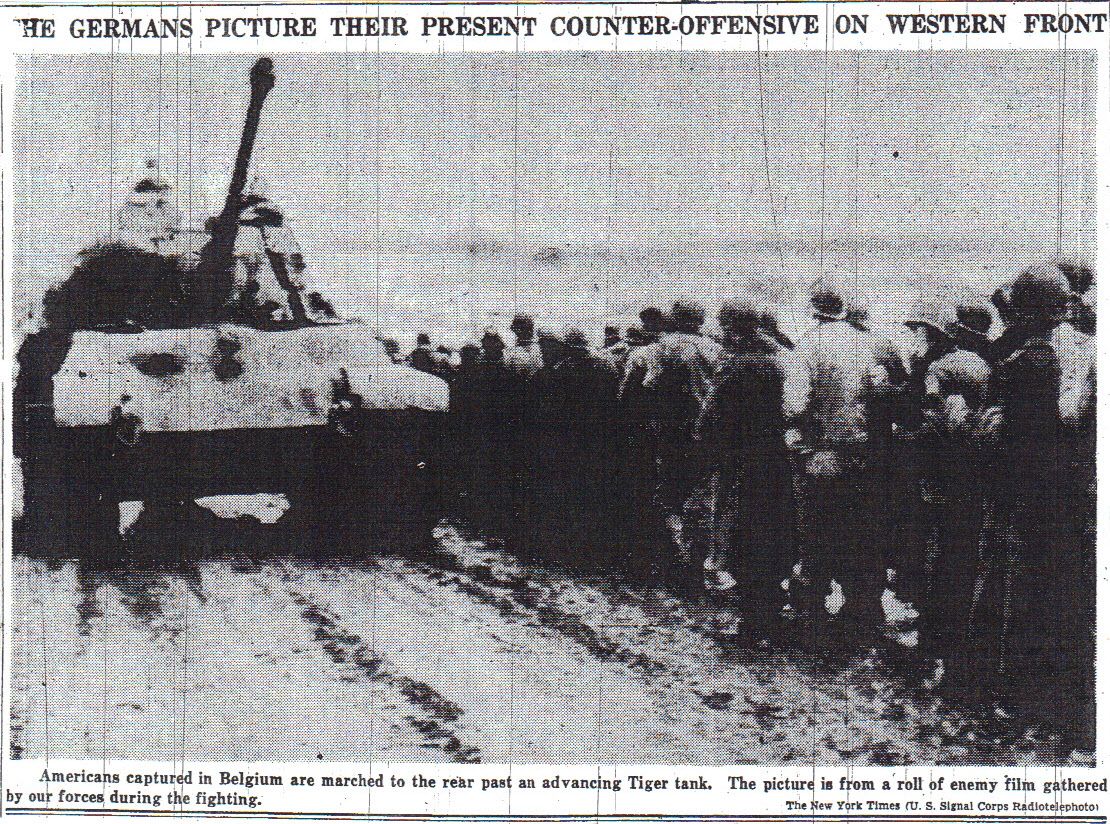

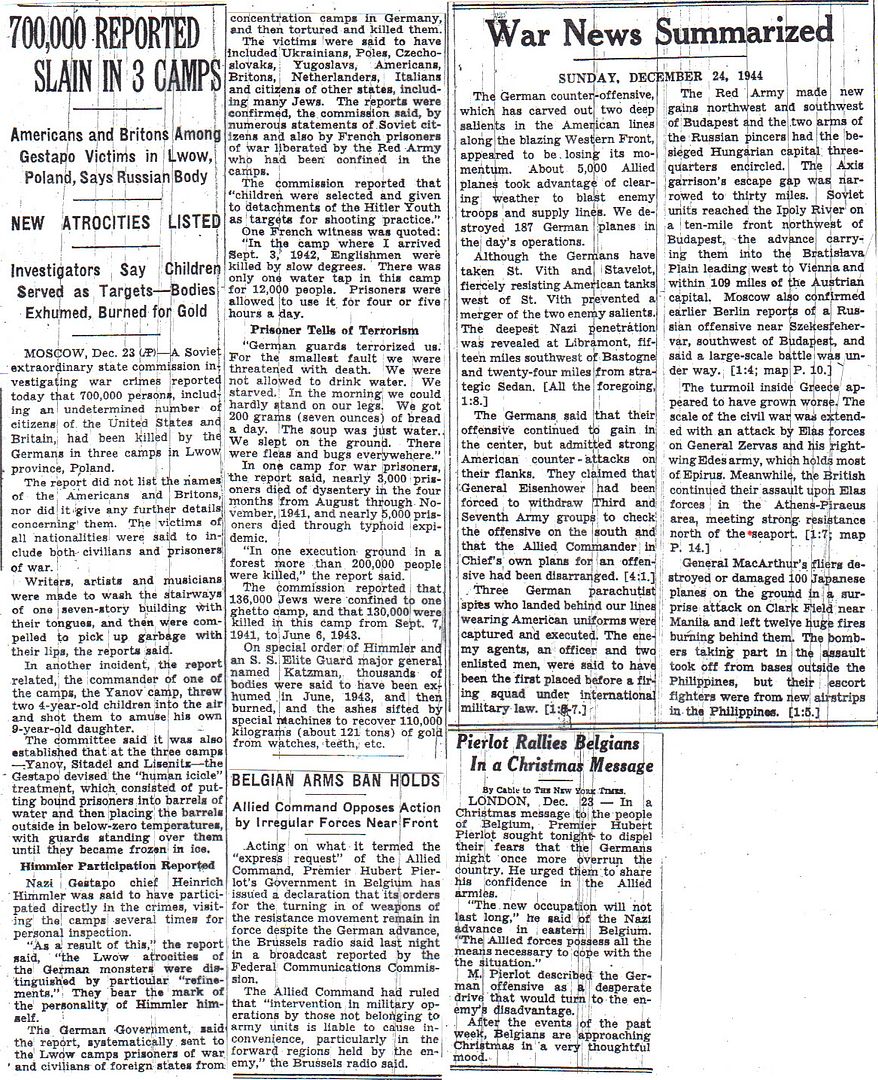


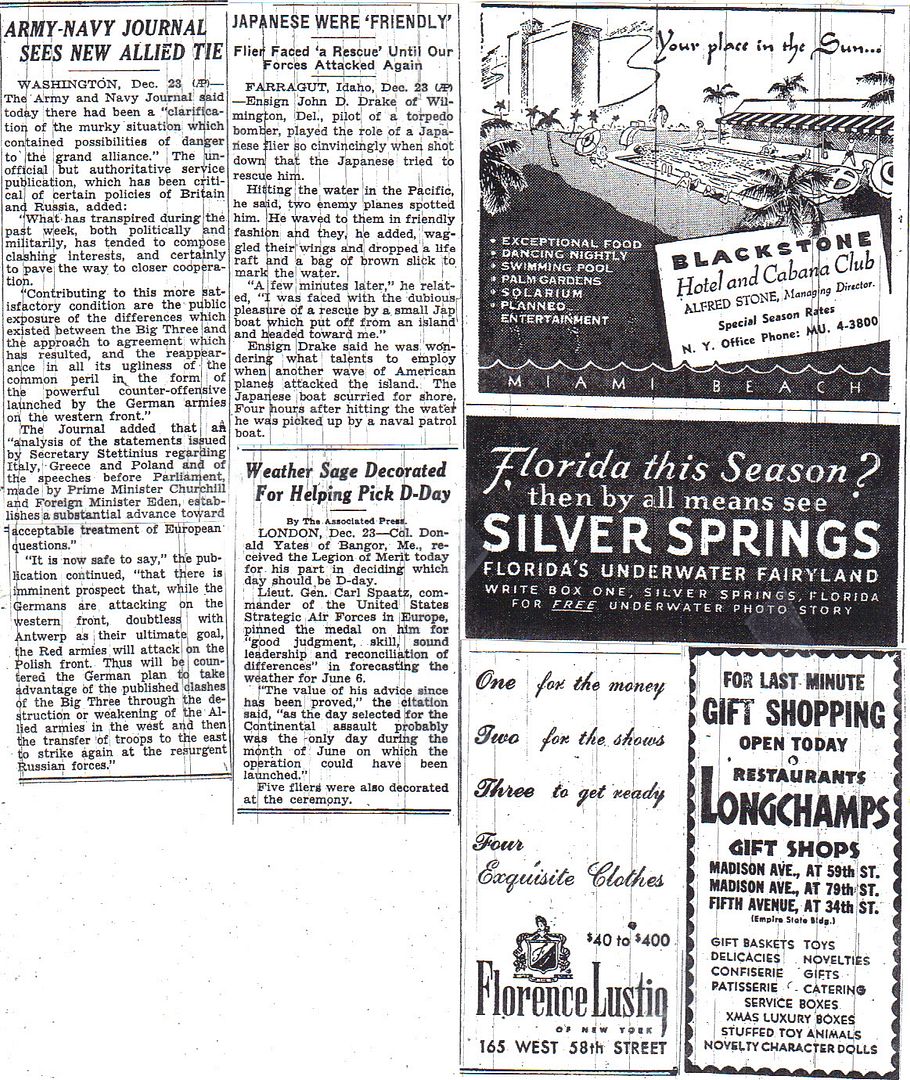
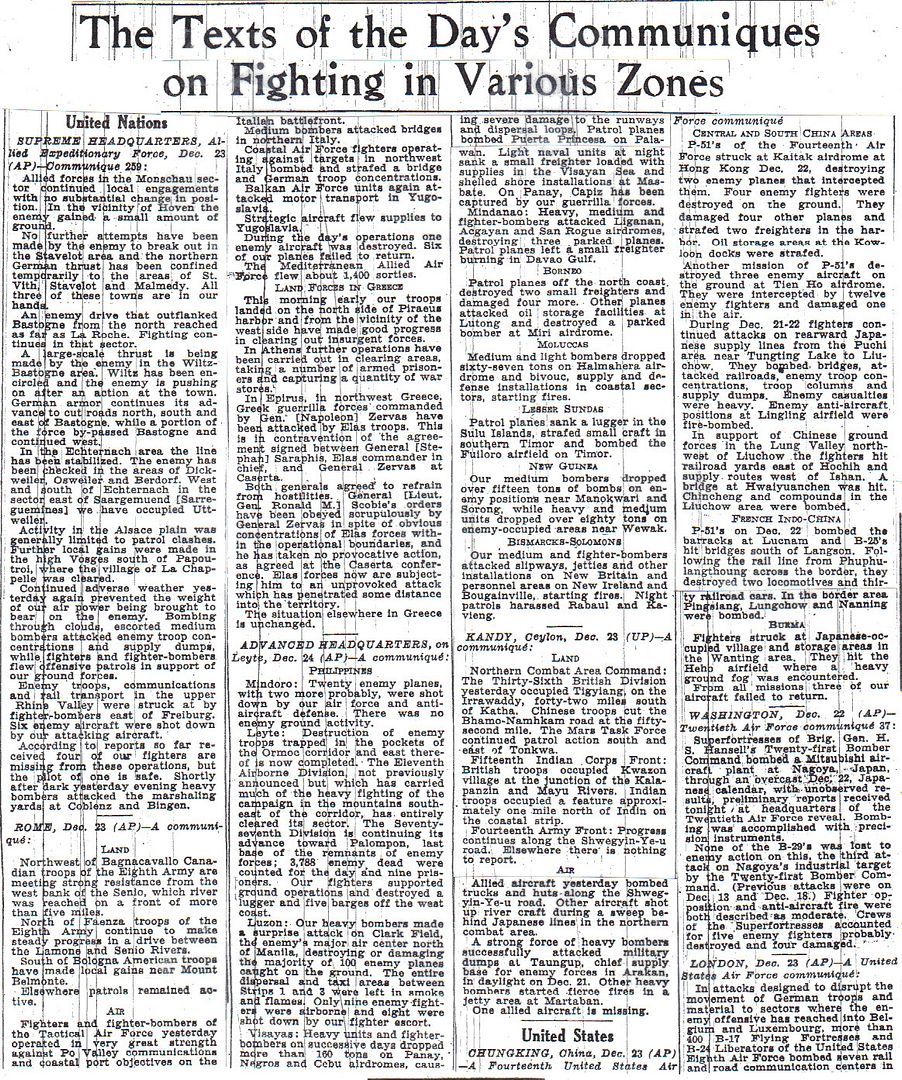

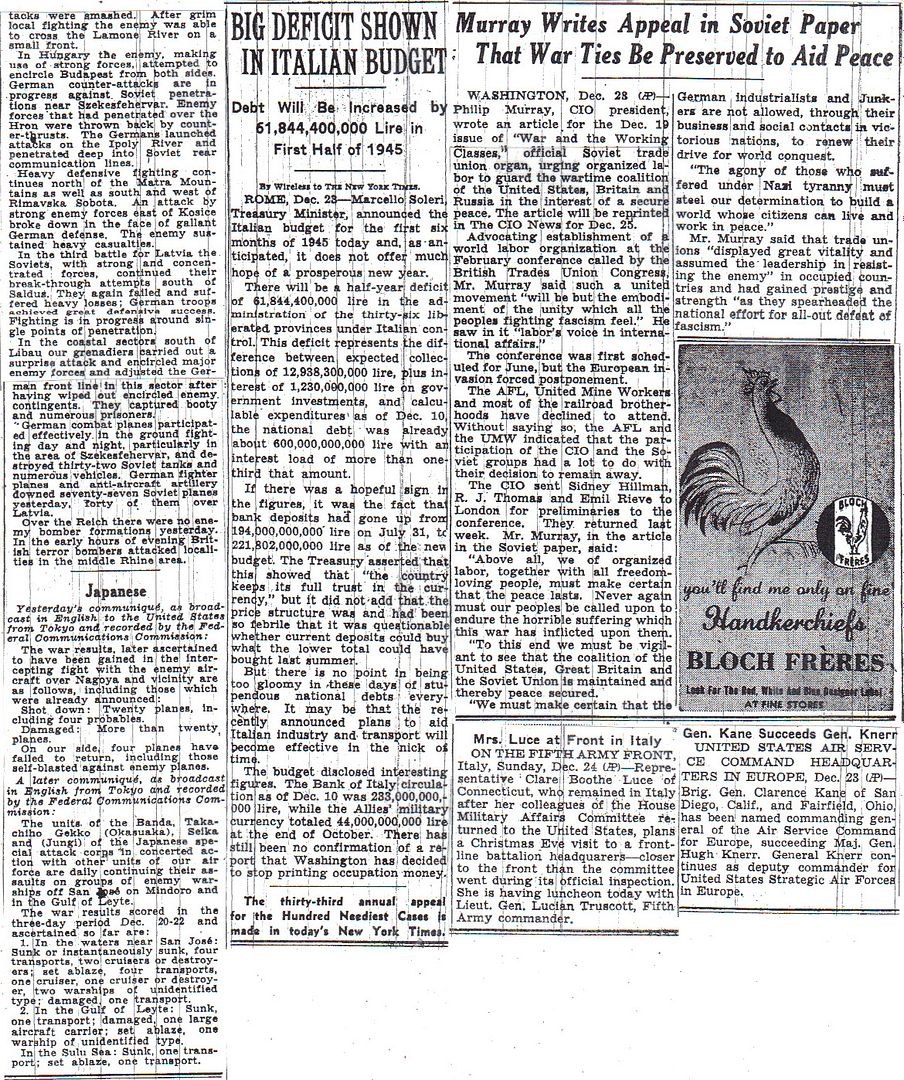
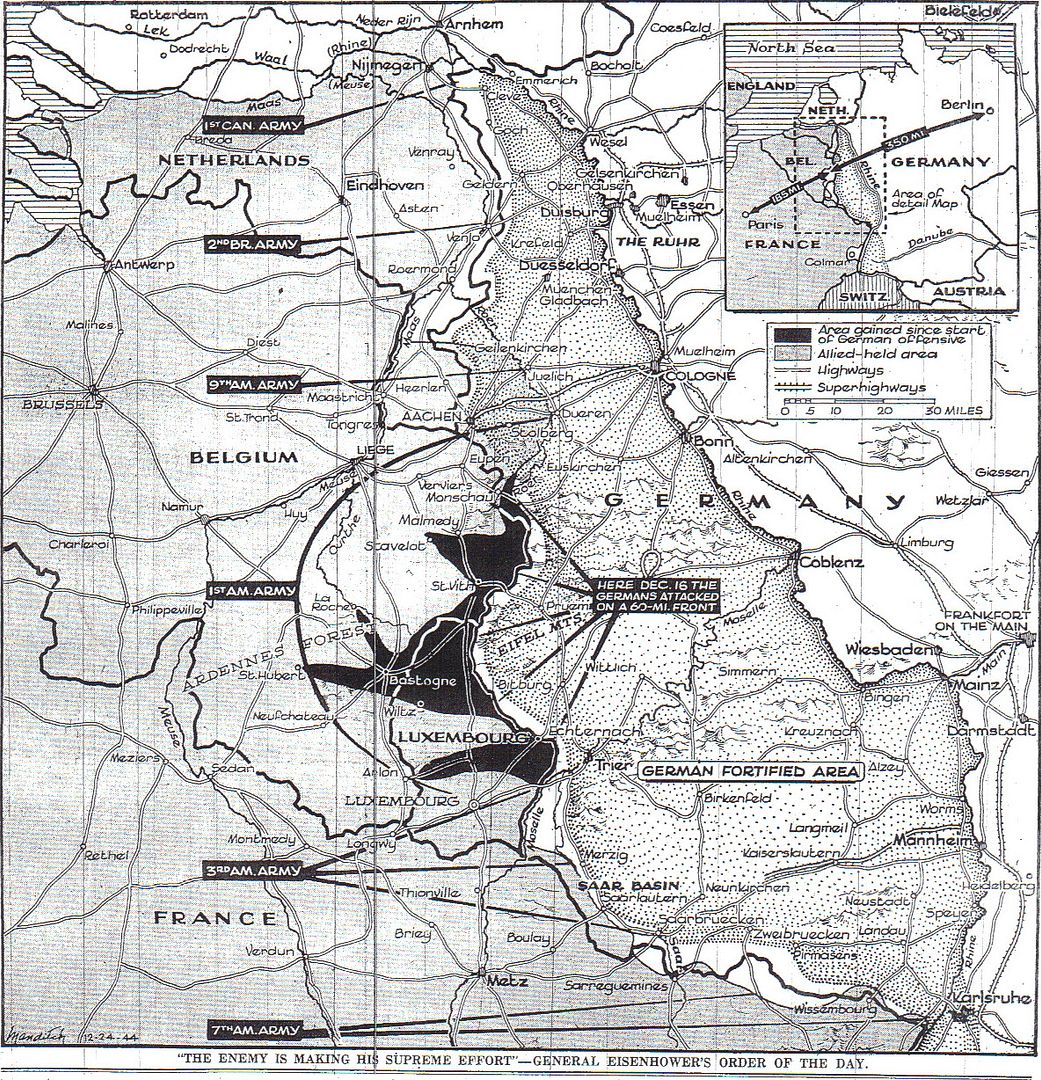
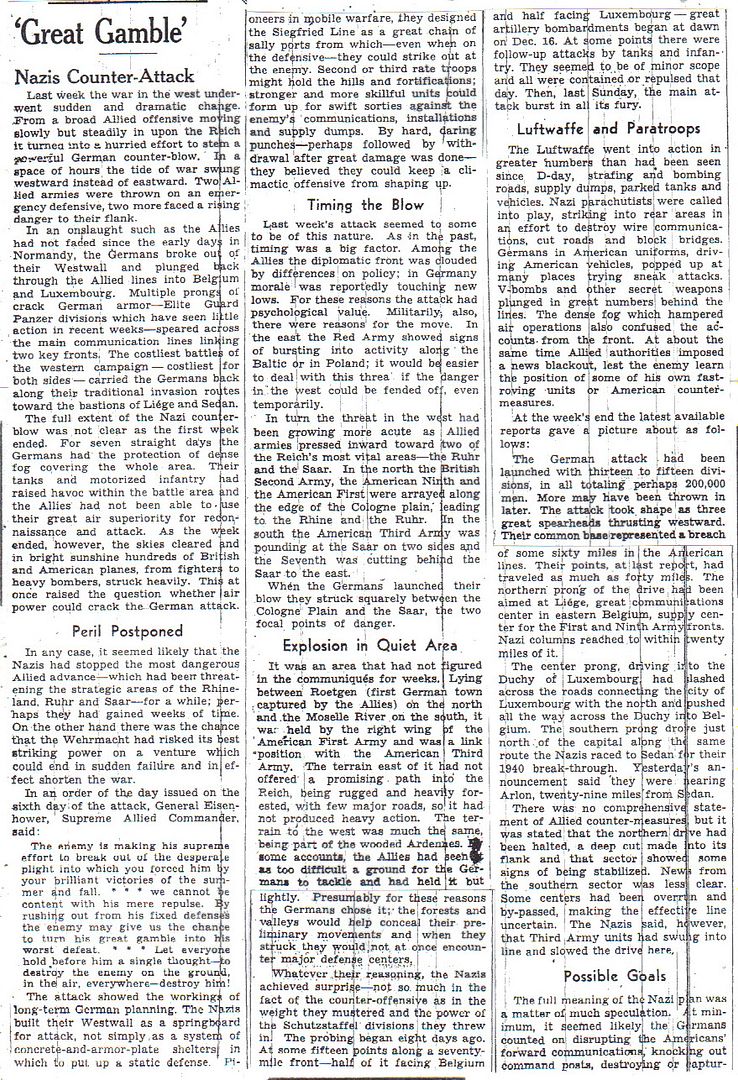
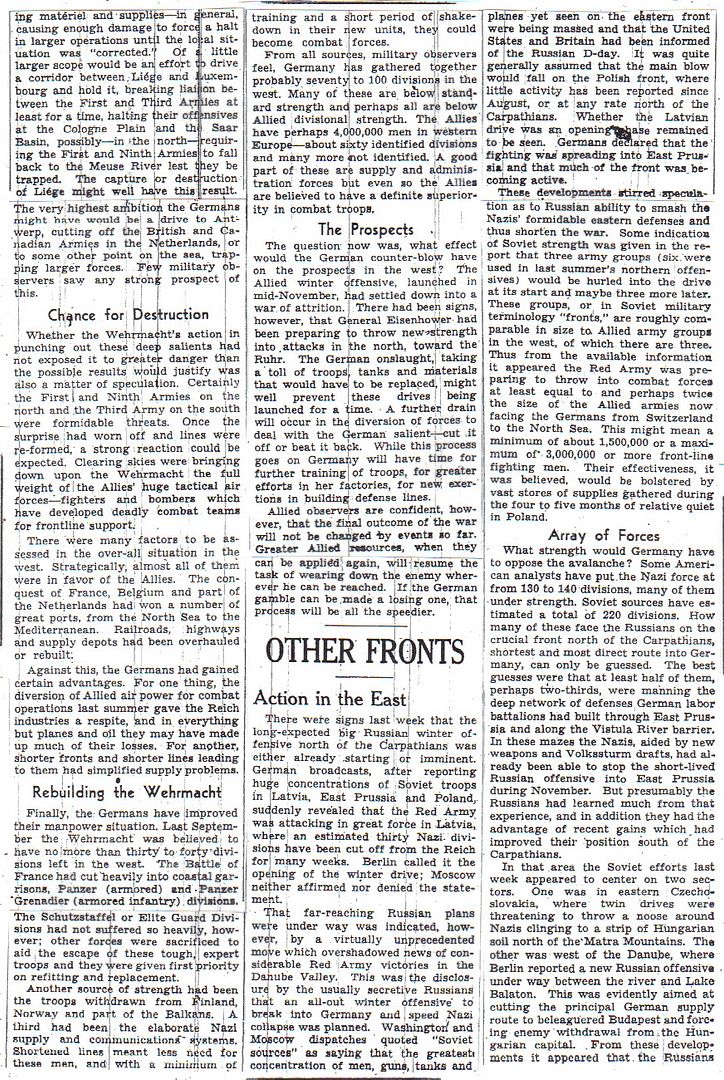
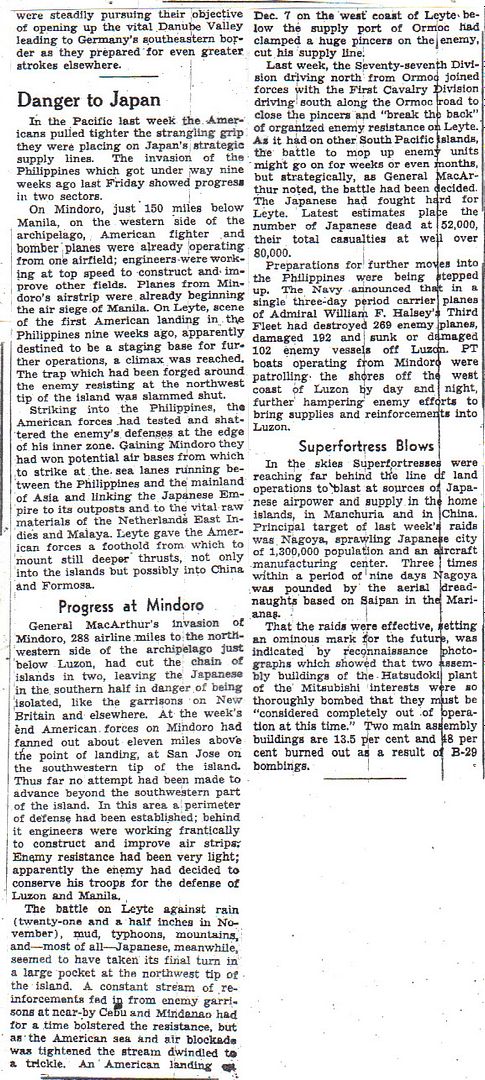
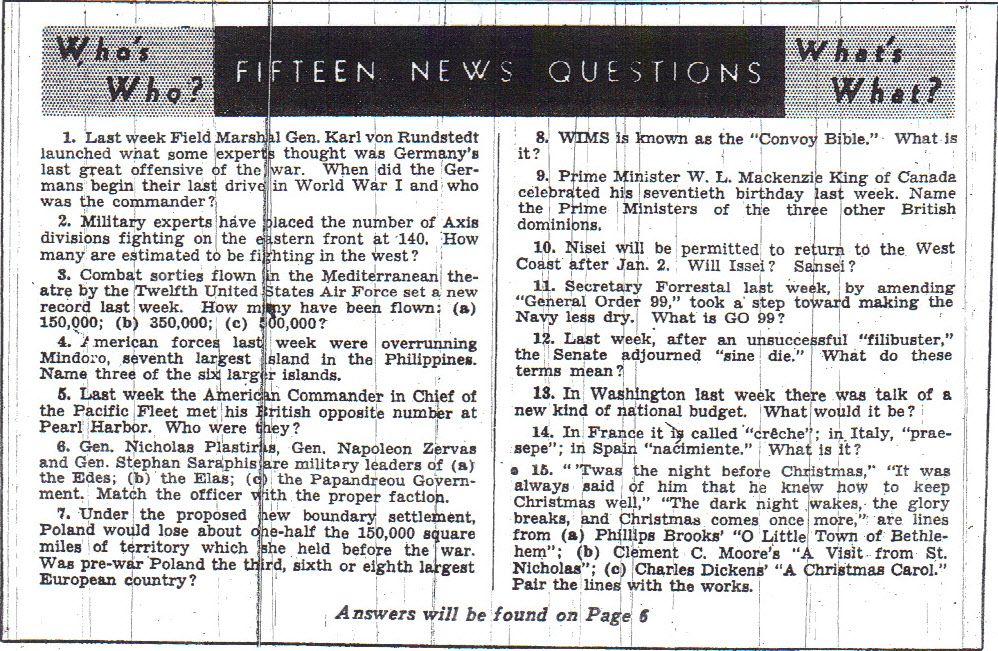
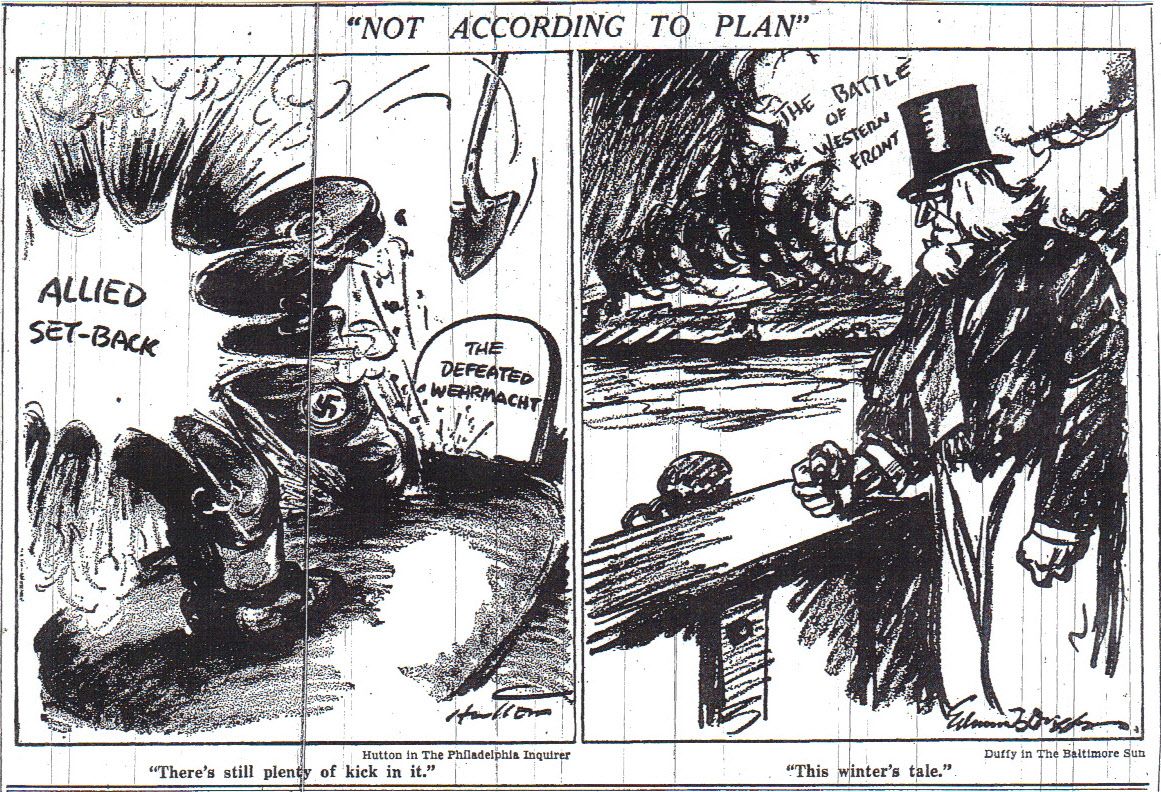
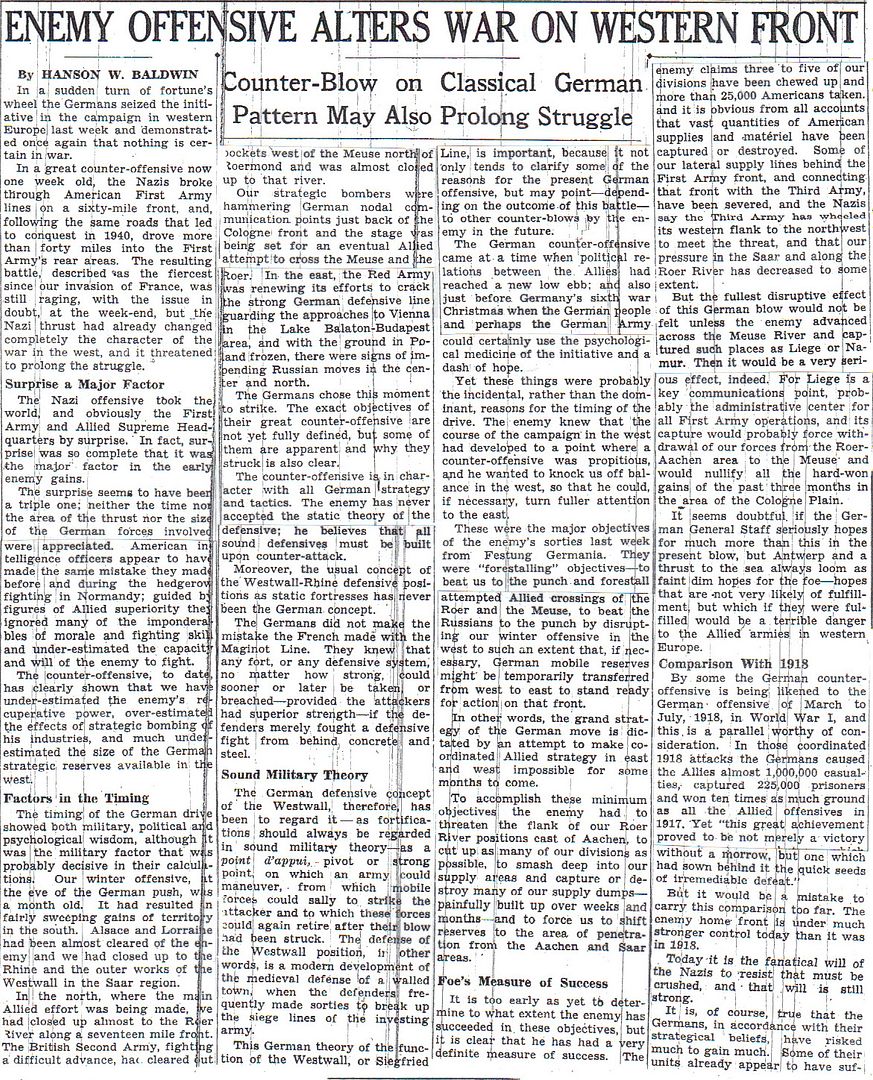
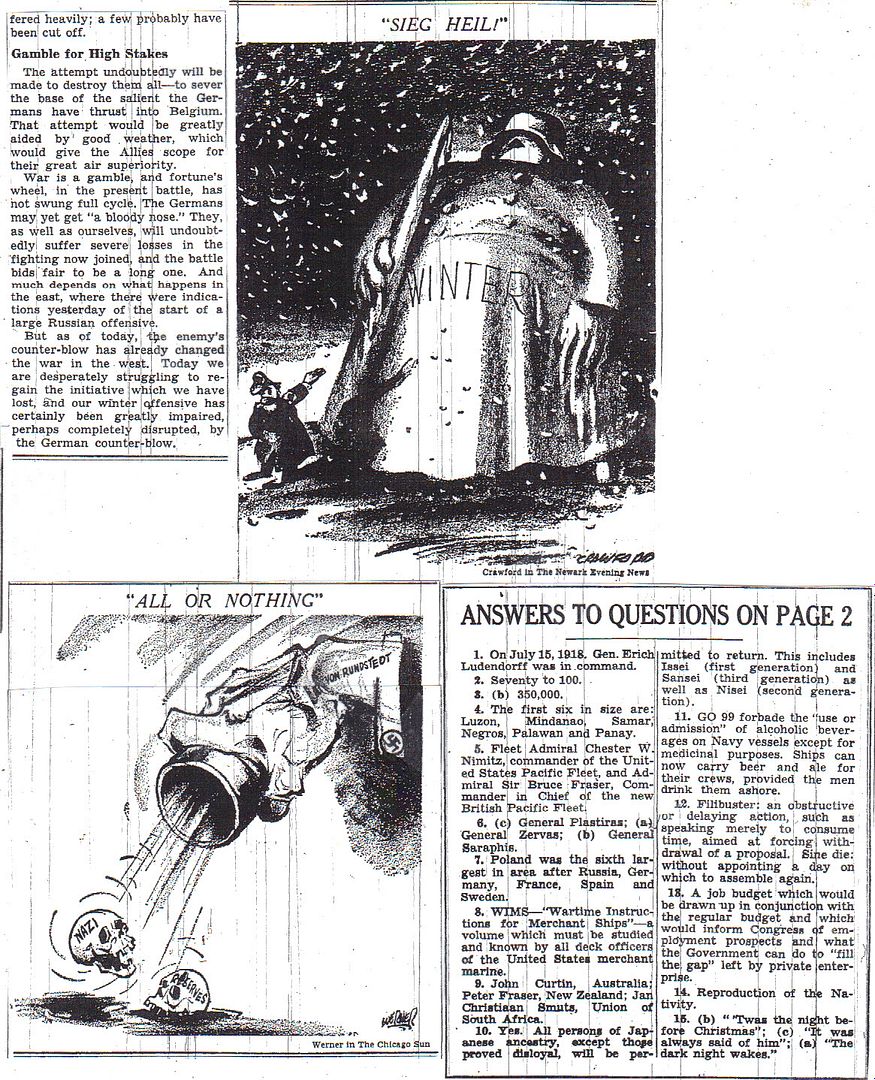
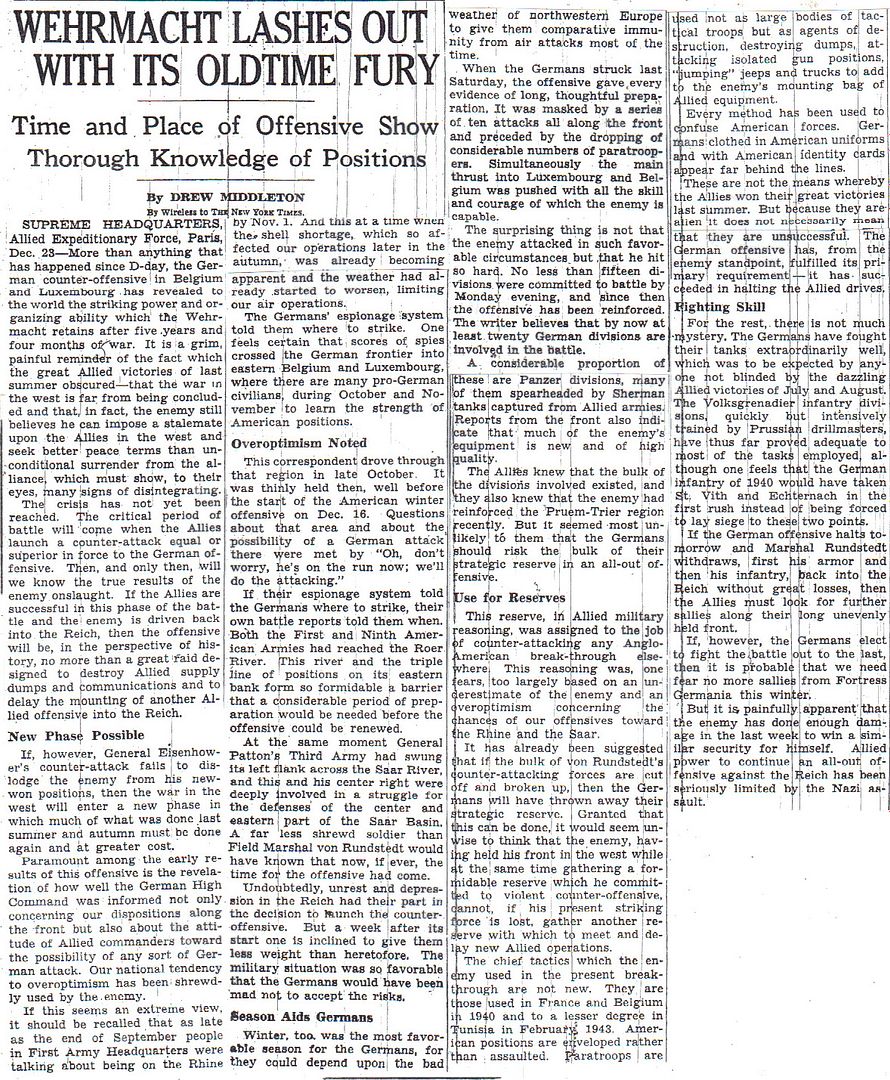
“The commanding officer of the 127TH Infantry [COL Stofft] said of the hills encountered on 24 December:
“The morning was spent in climbing to the top of a mountain ridge. The climbing was difficult but as we later found out, the descent was much worse. The trail led almost perpendicular down the side. After reaching the bottom, another ridge was encountered, this almost straight up, everyone had to use hand holds to pull themselves up. All in all there were seven ridges from the bottom of the first descent to the first possible bivouac area.” (Cannon 356)
U.S. Forces Stiffen (Middleton) – 2-3
Allies Execute 3 Parachutists Sent behind Line in American Uniforms – 4
German Generals Planning Their Offensive (photo) – 4
The Germans Picture Their Present Counter-Offensive on Western Front (photo) – 5
Red Army Scores – 6
700,000 Reported Slain in 3 Camps – 7
War News Summarized – 7
Nearly 100 Planes Wrecked at Manila (Kluckhohn) – 8
Japanese Shelling Our Positions on Leyte (photo) – 8
Tokyo is Attacked by Superfortress – 9
The Texts of the Day’s Communiques on Fighting in Various Zones – 11-13
Big Deficit Shown in Italian Budget – 13
Murray Writes Appeal in Soviet Paper That War Ties Be Preserved to Aid Peace – 13
The News of the Week in Review
“The Enemy is Making His Supreme Effort” – General Eisenhower’s Order of the Day (map) – 14
‘Great Gamble’ – 15-16
Other Fronts – 16-17
Fifteen News Questions – 18
“Not According to Plan” (cartoon) – 19
Enemy Offensive Alters War on Western Front (Baldwin) – 20-21
“Sieg Heil!” (cartoon) – 21
“All or Nothing” (cartoon) – 21
Answers to Fifteen News Questions – 21
Wehrmacht Lashes Out with Its Oldtime Fury (Middleton) – 22
http://www.etherit.co.uk/month/11/24.htm
December 24th, 1944 (SUNDAY)
UNITED KINGDOM: 45 modified Heinkel He-111s launch 31 V1 bombs aimed at Manchester; 17 reach the area, killing 32 people and injuring 49.
ENGLISH CHANNEL: U-486 torpedoed the SS Leopoldville in the English Channel just 7.5 miles north-northeast from the port of Cherbourg, France at 1754, in position 49.45N, 01.34W. The 11,509-ton Belgian troopship was transporting 2235 American soldiers from regiments of the 66th Infantry Division, which had left New York City on November 14. The ship finally sank 2 1/2 hours later. Everything that could went wrong; calls for help were mishandled, rescue craft were slow to the scene and the weather was unfavourable. Official records put the number of men lost at 802 but the exact number is not known due to the hurried departure at 0900 hours from Southampton and the unorganized boarding procedures. As no life jackets have been issued, the men of the Leopoldville die in the cold 9ºC waters of the English Channel. Most of the crew take off in the lifeboats, deserting the troops on board. The ship’s captain, Captain Limbor, is the only officer lost. The Allied authorities were embarrassed by the incident and decided to bury the case. Many loved ones were told the men were missing in action although they were already dead by then, later to be classified as killed in action.
The few survivors are rescued by the British destroyer HMS Brilliant (H 84) and transferred to the St. Nazaire/Lorient are, but 493 bodies are never found, presumably going down with the ship. It was not until 1996 that the files were opened to the public. U-486 had not said her last word as she sank the British frigates HMS Affleck and Capel only two days later in the same area before returning on 15 Jan 1945 to Bergen, Norway. Clive Cussler with the help of his shipwreck-hunting organization NUMA (National Underwater and Marine Agency) discovered the wreck of the SS Leopoldville. His book The Sea Hunters contains a chapter on the sinking which describes the incident from eyewitness accounts, and includes the story of the discovery of the wreck. The wreck of the Leopoldville lies on her port side in 180 feet (55 metres) of water in a remarkable state of preservation, in an area now used for testing nuclear submarines. (Dave Shirlaw and Tonya Allen)
The Canadian minesweeper HMCS Clayoquot (J 174) is struck by a G7s T5 Zaunkoning (Gnat) torpedo fired by German submarine U-806 while she is escorting the convoy XB-139 (Halifax, Nova Scotia, Canada, to Boston, Massachusetts, USA) and sinks about 17 nautical miles (32 kilometers) southeast of Halifax in position 44.25N, 63.20W. Eight of her crew are lost.
GERMANY: A high pressure front across western Europe brings clear weather and the USAAF Eighth Air Force launches Mission 760, a maximum effort against airfields and communications in western Germany. This was the largest air strike of the war with 2,034 heavy bombers (1,400 B-17 Flying Fortresses and 634 B-24 Liberators) and 853 fighters dispatched; they bomb over 65 targets and claim 92-6-21 Luftwaffe aircraft; 12 bombers and ten fighters are lost. The targets are (numbers in parenthesis indicate number of aircraft bombing and number lost, e.g., 97-1):
- Airfields hit: Griesheim at Darmstadt (175-0), Rheine Main at Frankfurt-am-Main (141-0), Merzhausen (115-0), Giessen (97-1), Biblis (86-0), Babenhausen (84-3), Zellhausen (83-3), Gross Ostheim (74-1), Kirch Gons (71-0) Ettinghausen (39-0) and Nidda (29-0).
- Communications centers hit: Wittlich (62-0), Mayen (60-0), Arhweiler (49-0), Bitburg (34-0), Schoneken (30-1), Ruwer and Pflazel (28-0), Daun (24-0), Rheinbach (17-0), Cochem (11-0), Prum (9-0) and Blumenthal (8-0).
- Marshalling yards (M/Ys) hit: Mosel M/Y at Koblenz (83-0), Gerolstein (69-0) Euskirchen (62-1), Kaiserslautern (39-0), Pforzheim (36-0) and Darmstadt (14-0).
- Railroad bridges and junctions hit: Eller (32-0), Ober and Rheinbach (9-0), and Mayen (1-0).
- 171 other bombers hit industrial area and targets of opportunity. (Skip Guidry and Jack McKillop)
Two hundred seventy six USAAF Ninth Air Force B-26 Marauders and A-20 Havocs hit rail bridges and communications centers in western Germany.
The largest bombing raid of the war occurs tonight, when 1,874 8th AF and 800 RAF bombers, escorted by 813 fighters bombed. Additionally, the 9th AF flew 1,157 effective fighter and fighter-bomber sorties. (Skip Guidry)
During the day, RAF Bomber Command dispatches 338 aircraft, 248 Halifaxes, 79 Lancasters and 11 Mosquitos, to attack Lohausen Airfield at Dusseldorf and Mülheim Airfield at Essen; 164 aircraft bomb Lohausen and 160 hit Mülheim. The purpose of the raids is not recorded; it is possible that they were to hinder the movement of supplies by transport aircraft from the Ruhr to the Ardennes battle area. Both attacks take place in conditions of good visibility and the bombing is accurate. Six aircraft are lost, two Lancasters and a Halifax from the Lohausen raid and three Halifaxes from the Mülheim raid.
During the night of 24/25 December, 104 RAF Bomber Command Lancasters are dispatched to bomb Hangelar Airfield at Bonn; 100 hit the target with the loss of one Lancaster. No results are known. In a second raid, 97 Lancasters and five Mosquitos are sent to bomb the Nippes marshalling yard at Cologne; 94 bomb the target with the loss of five Lancasters and two others crash in England. The Oboe marking and the resultant bombing are extremely accurate. The railway tracks are severely damaged and an ammunition train blows up. The nearby Butzweilerhof airfield is also damaged. In a third mission, two Mosquitos are sent to bomb Munster; one bombs the city.
In the U.S. Ninth Army’s XIX Corps area, the 83d Infantry Division, in limited attacks, clears about two thirds of Winden and the 8th Infantry Division improves positions near Obermaubach. The 104th Infantry Division takes responsibility for the northern part of the 83d Infantry Division zone, turning over its positions in the Inden-Pier-Schophoven region to the 29th Infantry Division.
BELGIUM: The German 2nd Panzer Division reaches Dinant by days end. The lead unit, KG Cochenhausen, reaches the small village of Foy-Notre Dame about 5 miles short of the Meuse River bridges at Dinant. This will be the farthest penetration during the offensive. They can go no further and abandon their vehicles, walking back to their own lines. The US 1st and 3rd Armies along with the British XXX Corps, 29th Armoured Brigade and the 101st Airborne have halted the German offensive.
Oberst Heinz Kokott, Commanding 26 Volks Grenadier Division:
“In preparation for the attack on 25 December, the division command post on 24 December was moved to Gives (respectively, forward command post to Givry). The day was quiet, aside from lively activity by enemy fighter-bombers and supply planes flying into Bastogne.
“The division was re-organized for the attack which was now to be carried out with the main effort in the northwestern sector towards Bastogne and into Bastogne.
“The division commander on 24 December called on the regiments and battalions surrounding Bastogne in a closed circle to discuss with their leaders the plans for the attack and to reconnoiter the terrain. The troops everywhere appeared to be in good spirits. Despite exhaustion, strain and , in some cases, very heavy losses, the men were confident and were ready to give their utmost to the tasks ahead. The supply situation was difficult. The uninterrupted fighter-bomber attacks made, as already mentioned, all supply and other major movements possible only during the evening and night hours. The supply roads were under artillery fire and were frequently jammed and blocked.
“Regarding the overall situation, it was known on 24 December that the 2nd Panzer Division was engaged in heavy fighting south and west of Marche and that the Panzer Lehr Division was advancing via Rochefort. At the unit to the right - the 5th Parachute Infantry Division - the situation had not grown anymore tense. To the contrary, successful engagement with the enemy pushing up from the south was reported. An immediate threat to our troops - facing Bastogne - was considered out of the question. The 5th Parachute Infantry Division was already aware of the importance of the flank protection for the 26th Division and had doubtlessly done everything in its power to safeguard this protection.
“In spite of that, however, the 26th Division as an additonal measure to protect its rear, had formed a security screen to the south and southwest. Along the line (north of) Clochimont - Sibret - along the ‘Brul Bach’ (creek), outposts - strengthened by individual anti-tank guns and blocking devices - were committed near Floahamont, Brul and Hubermont. These guards were taken from ‘emergency platoons’ (supply personnel) and elements of the Replacement Training Battalion.
“The anti-aircraft installations near Hompre were prepared to be, if necessary, used for ground fire, with the front to the south. “Rifle Regiment 39 which would be the first to expect an enemy thrust to its rear, committed all possible manpower from staffs and supply formations for all around defence, especially at Assenois, Villeroux and Sibret.
“The highway to the south was secured by Panzer Grenadier regiment 901 with tanks and was thoroughly blocked with anti-tank guns, mines and blocking devices of all types.
“Everything possible was done to detain the enemy in the south atleast for the duration of the attack on Bastogne. “The attack plan for 25 December called for a strong push from the west, while at the same time the enemy would be warded off and tied down through harassing attacks in the east and southeast.
“The entire Panzer Grenadier Division was to carry out the main thrust in a narrow, deeply staggered formation.
“”The elements of the 26th Division adjoining to the right and left - particularly Reconnaissance Battalion 26 and Regiment 77, but also Regiment 39 - were to accompany the attack, to increase its force and to screen off the flanks of the main thrust.
“With one concentrated main effort, the defence ring was to be blasted at a single point and the door to Bastogne to be pushed open.
With one and a half divisions (15th panzer Grenadier Division and available, but now weakened, elements of the 26th Division) it was now - against threatening enemy pressure from the south - necessary to try the same thing which previously, when there were still three relatively strong divisions to the east of the town (2nd Panzer Division, 26th Division, Panzer Lehr Division), had certainly been accomplished with less effort.
Perhaps something was lost in the translation here. I believe that General Kokott is trying to tell us that he now had to try to accomplish what was not previously accomplished by three divisions. As for one and a half divisions, ptobably he had no more than one full strength division. The 26th had suffered heavy casualties since 16 December and he will describ the 15th as less than one half a division when it reported in on the Bastogne front.
“In the east and southeast, the vastly expanded Regiment 78 as well as the greatly weakened Panzer Grenadier Regiment 901 were to tie down and neutralize the enemy through short thrusts with limited objectives.
“In the north - i.e. between Foy and Longchanps - northing could be undertaken on the German side. The forces were lacking. The forces occupying that sector had decreasaed to a point where their effectiveness was most questionable. With a good deal of anxiety, the division had watched that area for quite some time and it appeared inevitable that any enemy threat in platoon strength strength would be successful there. The enemy had fortunately abstained from such action up to that time.
“The northwest sector - i.e. the area extending from Champs (inclusive) to mande-St. Etienne - had been selected as the area for the main thrust/ “The terrain was most suitable for an armored attack. The small gullies (now covered with snow) there did not present and hindrance.
The terrain offered a clear view for observing the effectiveness of artillery and supporting heavy infantry weapons. Between the highway to the west and the road Hemroulle - Champs there were no villages and major wooded sections which, as experience had shown, always caused drawn-out engagements which took much time.
“There was furthermore reason to expect that in that sector of the front the enemy would be less ready for defence than had proven in all other sectors - the eastern, southeastern and southwestern ones - where he had been attacked.
“The individual missions were as follows”
“The 15th Panzer Grenadier Division, located at the point of main effort, after having assembled in the area around Flamizoulle, was to pierce the enemy front between Grandes Franges and the highway to the west and was then to drive on to Bastogne between the highway to the west and hemroulle. Initial objective: country road Henroulle - Isle-la-Hesse.
“Reconnaissance Battalion 26 - starting from the area around Mande-St. Etienne - was to proceed along both side of the highway to the west, was to protect the right flank of the main thrust and, for its initial objective, was to capture Henroulle.
“Rifle Regiment 39 had the mission to link up with the attack by the northwestern group and, in tis drive on Bastogne - with main effort on both sides of the railroad and road to Neufchateau -, to capture Isle-le-Bre as its first objective.
“Panzer Grenadier regiment 901, by means of assault troops operations between Marvie and highway to he south, was to ward off and tie down the enemy.
“Grenadier Regiment 78 was to conduct attacks with limited objective through sizeable assault detachments on both side of the Bourcy - Bastogne railroad line and also minor operations south of Neffe.
“In the sector between (northwest of) Recogne and Longchamps, the groups of Regiment 77 functioning as security detachments there, were replaced by Emergency platoons. Elements of Engineer Battalion 26, remnants of the Replacement Training Battalion (strengthened by emergency platoons) and the Division Combat School were retained as reserves (total f about 120, 150 men) in the area between Givry and Flamizoulle.
“The entire artillery of the 15th Panzer Grenadier Division, the bulk of the artillery of the 26th Division and the attached reinforcement artillery from the several heavy batteries O10cm guns, 15cm howitzers and mortars) had been assembled to the rear of the attack wedge - particularly in the Flamierge - Givry area. Numerous forward observers were to accompany the advance of the infantry and the tanks. All other batteries in the area surrounding Bastogne were hooked up to the main fire control net and were able to enter the battle at crucial points with observed fire. Charged with overall fire control was the senior artillery officer of the Fifth Panzer Army and he was attached to the 26th Division.”
“Both army and corps promised the division the support of the German air force for the attack.
” . . . the division did not rely on this promise.
“As to the time for the infantry attack by the main group, the dark morning hours of 25 December were designated. It was calculated that, with the infantry attack by 0700 hours, i.e. as soon as it would be light enough to fire; then it would be possible for the armored wedge of the 15th Panzer Grenadier Division, together with the auxiliary infantry, to drive forward through the opening, covered at the right flank and accompanied by the tank destroyers and riflemen of the Reconnaissance Battalion 26.
“The division was trying its utmost to get up to Bastogne between 0900 and 1000 hours or even to be inside Bastogne by that time.”
When the advance elements of the 15th Panzer Grenadier Division reported into the division CP they were briefed on the attack. The division commander reported that the units he would have available for the attack were “. . . 1 ½ Grenadier battalions with weak companies, 1 battalion of armored reconnaissance infantry with about 24 to 30 armored personnel carriers, and armored group of about 20 tanks or assault guns, one company of engineers and two motorized artillery battalions.”
“A final group of this division with an additional 10 to 15 tanks, several Grenadier companies and batteries was to be expected but would not arrive prior to 26 December.!
The division commander was disappointed in this and felt that there would be fluctuating in te fighting unless he got lucky. He was not to get lucky.
“The decision of Army Group Model to push this depleted 15th Panzer Grenadier Division for the large scale attack on Bastogne, appeared incomprehensible. This measure could - as had been felt by the troops for some time - only be an indication that Army Group Model, at least, was in no way aware of the extreme difficulty of the battle and the very high losses.”
The division commander felt that he had been deceived but that the fighting spirit and determination of the soldiers and their leaders would carry the day.
“Towards midnight of 24/25 December, several German planes appeared over Bastogne and dropped some bombs. (On the evening of 25 December, it became known that this bombing venture was to be the promised air support for the entire attack!)” (Jay Stone)
An aviation first was scored today with the world’s first jet bomber operation. Just before 11am German Arado 234B “Blitz” bombers, based at Münster-Lukesch, made a successful attack on a factory and marshalling yards at Liege, Belgium. All the jet bombers returned safely, although one damaged its undercarriage on landing. Later the jets returned to the same target, a vital supply centre for the fighting in the Ardennes, and enjoyed equal success.
GENERAL McAULIFFE’S CHRISTMAS MESSAGE — 1944
Headquarters, 101st Airborne Division
Office of the Division Commander
24 December 1944
What’s Merry about all this, you ask? We’re fighting – it’s cold – we aren’t home. All true, but what has the proud Eagle Division accomplished with its worthy comrades of the 10th Armored Division, the 705th Tank Destroyer Battalion and all the rest? Just this: We have stopped cold everything that has been thrown at us from the North, East, South, and West. We have identifications from four German Panzer Divisions, two German Infantry Divisions, and one German Parachute Division. These units, spearheading, the last disparate German image, were headed straight west for key points when the Eagle Division was hurriedly ordered to stop the advance. How effectively this was done will be in history’s not alone in the Division’s glorious history but in the World history. The Germans actually did surround us, their radios blared our doom. Their commander demanded our surrender in the following arrogance:
“To the U.S.A. Commander of the encircled town of Bastogne.
The fortune of war is changing. This time the U.S.A. forces in and near Bastogne have been encircled by strong German armored units. More German armored units have crossed the river Our near Ortheuville, have taken Marche and reached St. Hubert by passing through Hompre-Sibret-Tillet. Libramont is in German hands.
There is only one possibility to save the encircled U.S.A. troops from total annihilation: that is the honorable surrender of the encircled town. In order to think it over a term of two hours will be granted beginning with the presentation of this note.
If this proposal should be rejected one German Artillery Corps and six heavy A. A. Battalions are ready to annihilate the U.S.A. troops in and near Bastogne. The order for firing will be given immediately after this two hours’ term.
All the serious civilian losses caused by this artillery fire would not correspond with the well known American humanity.”
- The German Commander.
REPLY to the German Commander:
NUTS!
(Russell Folsom, Jeff Chrisman)
BELGIUM: German troops murder all men aged between 17 and 32 in the village of Bande, as revenge for a Maquis attack in September. These troops include a Swiss national, Ernst Haldiman, who was an SD member. More.... (Frederick L. Clemens)
Brig. Gen. Frederick Castle was killed in action when the B-17 he was co-piloting was shot down. The usual co-pilot, Lt. RW Harriman, was in the tail, acting as “Formation Officer”. It is reported by several residents of Fraiture, Belgium that Lt. Harriman was fired upon while in his ‘chute and he returned fire, but was dead when he hit the ground. (Tim Erskine)
In U.S. First Army’s V Corps area, the 1st Infantry Division repels another German bid for Butgenbach. The 5th Armored Division closes in the Eupen area and is held in reserve. In the XVIII Corps (Airborne) area, the 30th Infantry Division overruns La Gleize and releases Combat Command B, 3d Armored Division. The 82d Airborne Division is under strong pressure in the Manhay area; loses Manhay, although elements of the 7th Armored Division are pressed into action in that region. In the VII Corps area, the Germans reduce the 3d Armored Division’s roadblock at Belle Haie, on the road to Manhay; Combat Command R columns attacking east from Hotton and west from Soy clear the Hotton-Soy road. Elements of the 75th Infantry Division enter combat for the first time: Regimental Combat Teams 290 and 289 are attached respectively to Combat Command R and Combat Command A, 3d Armored Division. In the 84th Infantry Division zone, the Germans drive through Verdenne. Combat Command A, 2d
Armored Division, reaches Buissonville; the 4th Cavalry Group (Mechanized), attached to the 2d Armored Division to cover its assembly and maintain contact with adjacent units, makes contact with the British at Sorinne.
In the U.S. Third Army’s VIII Corps area, heavy fighting continues around Bastogne perimeter. The city is badly damaged by air attacks but 160 USAAF IX Troop Carrier Command C-47 Skytrains drop 160 tons (145 metric tonnes) of supplies. The 11th Armored Division, released from Supreme Headquarters Allied Expeditionary Force (SHAEF) reserve to the corps on yesterday, is held in mobile reserve west of the Meuse River. Combat engineers are guarding the Meuse River line and blocking approaches to bridges. The 17th Airborne Division is being flown to France from England and subsequently operates under VIII Corps. In the III Corps area, Combat Command B of the 4th Armored Division is meeting lively opposition south of Chaumont, as is Combat Command A at Warnock; The 6th Cavalry Group (Mechanized) (Task Force Fickett) arrives from the XX Corps front to guard west flank of corps in Neufchateau area.
LUXEMBOURG: In the U.S. Third Army’s III Corps area, Combat Command R seizes Bigonville. The 318th Infantry Regiment (—), 80th Infantry Division, is attached to the 4th Armored Division.; the 6th Cavalry Reconnaissance Squadron is assigned the sector between 4th Armored and 26th Infantry Divisions. The 26th Infantry Division secures Rambrouch and Koetschette but is held up at Arsdorf and Hierheck. The 80th Infantry Division contains determined counterattacks. In the XII Corps area, the 5th Infantry Division, to which Regimental Combat Team 10 has reverted, relieves the left flank elements of 4th Infantry Division and attacks toward HaIler and Waldbillig, making slow progress. The 2d Cavalry Group (Mechanized), designated Task Force Reed, relieves the right flank units of 4th Infantry Division along the Moselle River. Combat Command A, 10th Armored Division, captures Gilsdorf and Mostroff on the Sauer River.
FRANCE: HQ 6th Army Group warns that the Germans are massing for an offensive.
In the French Army’s II Corps area, the U.S. 3d Infantry Division clears Bennwihr, concluding operations in the Colmar sector.
The USAAF Eighth Air Force flies Mission 759: Ten B-24 Liberators hit the La Pallice coastal battery in France without loss.
NORWAY: RAF Bomber Command sends 12 Halifaxes to lay mines off Oslo; all complete the mission without loss.
HUNGARY: The eastern outskirts of Budapest is the scene of heavy fighting between the Germans and Russians. The Red Army narrows the German escape gap from Budapest to less than 20 miles (32 kilometers). Moscow reveals that the Third Ukrainian Front, in a three-day-old offensive, has achieved a breakthrough southwest of Budapest in the Lake Velencei-Danube River sector and has surged forward 25 miles (40 kilometers), overrunning more than 160 towns and villages; with the capture of Szekesfehervar and Biske, key points in the outer defenses of Budapest, the western escape routes from the besieged city are closed. Other troops of this front are pushing in on Budapest from the southwest.
BALTIC SEA: At 0928, U-637 fired a spread of three FAT torpedoes at an unknown Soviet convoy of Cape Pakri in the Baltic Sea and heard a detonation after 3 minutes 44 seconds followed by sinking noises. At 0949, a Gnat missed its target and at 1009 another Gnat was followed by a detonation after 3 minutes and then sinking noises. According to Soviet sources only BMO-594 Baltiec was lost.
ITALY: Weather again holds USAAF Twelfth Air Force operations to a minimum however, P-47 Thunderbolts carry out very successful raid on Thiene Airfield in northeastern Italy, causing considerable damage and destroying several German airplanes; other missions find little activity and result in the destruction of only a few trucks and trains.
INDIA: The Japanese fly their last bombing raid against Calcutta.
CHINA: Six USAAF Fourteenth Air Force B-25 Mitchells blast the Kunlong ferry area and three B-24 Liberators claim a tanker sunk in the South China Sea. Over 100 P-40s, P-51 Mustangs, and P-38 Lightnings on armed reconnaissance attack targets of opportunity throughout southern China, especially river, road, and rail traffic, troops, and buildings around Hengyang, Lingling, Siangtan, and Changsha. Hong Kong area shipping is attacked (a tanker claimed sunk and other ships damaged) and over 30 Japanese aircraft claimed destroyed at Tsinan Airfield.
BURMA: In the British Fourteenth Army’s XXXIII Corps area, the British 2d and Indian 20th Divisions overcome strong opposition in Pyingaing.
Thirty eight USAAF Tenth Air Force P-47 Thunderbolts hit troop concentrations and supply areas at Pangkai, Man Namman, Man Om, Mong Nge, and Kyanhnyat; six support ground forces in the Si-U sector while 12 hit targets of opportunity along the Sinlum-Nawghkio rail line; and eight P-47s strafe the Lashio Airfield..
VOLCANO ISLANDS: Fifty USAAF Seventh Air Force B-24 Liberators from the Mariana Islands strike Iwo Jima and 17 P-38 Lightnings make a low-level strafing attack on the island. During the night of 24/25 December, two B-24s fly harassment strikes over Iwo Jima.
The USAAF Twentieth Air Force’s XXI Bomber Command flies Mission 15: 29 Mariana Island-based B-29 Superfortresses are dispatched to attack two airfields on Iwo Jima; 23 hit the primary targets and one hits an alternate target without loss.
USN Task Group 94.9, the heavy cruisers USS Chester (CA-27), Pensacola (CA-24) and Salt Lake City (CA-25), and nine destroyers, follows the USAAF bombing raids on Iwo Jima by shelling the airstrips and other installations there; destroyers USS Case (DD-370) and Roe (DD-418) sink Japanese fast transport T.8 and landing ship T.157.
COMMONWEALTH OF THE PHILIPPINES: In the U.S. Sixth Army’s X Corps area on Leyte, the 1st Cavalry Division continues steadily west against scattered resistance, the 12th Cavalry Regiment (Infantry) wading swamps in its sector. The 32d Infantry Division, with the 127th and 128th Infantry Regiments in assault, starts west toward the coast on northern flank of the corps, slowed more by terrain than resistance. In the XXIV Corps area, the 1st Battalion (reinforced), 305th Infantry Regiment, 77th Infantry Division, embarks at Ormoc and at 2000 hours sails for Palompon, the convoy protected by motor torpedo boats (PTs). The 305th Infantry Regiment, less the 1st Battalion, is lightly opposed as it continues west along the road to Palompon.
USAAF Far East Air Forces B-24 Liberators bomb Clark Field on Luzon Island and Puerto Princesa Airfield on Palawan Island. B-25 Mitchells bomb Silay Airfield on Negros Island and on Mindanao Island, hit San Roque barracks, the Zamboanga waterfront, and Davao Bay shipping. Again FEAF aircraft on miscellaneous small operations attack many targets throughout the Philippine Islands. P-47 Thunderbolt pilots shoot down 33 Japanese fighters over Luzon between 1015 and 1150 hours; four P-47s are lost.
During the night of 24/25 December, a Japanese bomber destroys a 100,000 U.S. gallon (83,267 Imperial gallons or 379 kiloliters) aviation storage tank at Hill Field on Mindoro Island. As a result, flight operations are restricted from this base for several weeks.
EAST INDIES: USAAF Far East Air Forces attack Kudat Airfield in North Borneo and B-25 Mitchells and fighter-bombers attack the Goeroea area in the Moluccas Islands of the Netherlands East Indies (NEI). Again FEAF aircraft on miscellaneous small operations attack many targets throughout the NEI.
BONIN ISLANDS: Twenty three USAAF Seventh Air Force B-24 Liberators bomb Chichi Jima Island.
PACIFIC OCEAN: SS Robert J Walker (US-flagged Liberty ship) sunk by U-862 160 miles off Australia 36.45S, 150.43E - Grid VD 8222. Two crewmembers killed. She was the only ship sunk in the Pacific Ocean by a German U-boat.
MARIANAS ISLANDS: USAAF 313th Bombardment Wing (Very Heavy) arrives on the islands.
TERRITORY OF ALASKA: A paper Japanese Fu Go balloon with the usual equipment lands at Holy Cross, Territory of Alaska. Holy Cross is located in southwestern Alaska about 235 miles (378 kilometers) southeast of Nome.
U.S.A.: Beef rationing and quotas for most other commodities are reintroduced by the Office of Price Administration Administrator Chester Bowles announces that canned peas, corn, green and wax beans, asparagus and spinach will be rationed beginning 1 January 1945. At the same time, beef rationing is reintroduced.
Camp Papago Park, Arizona. 25 German PoWs escape after digging a 200 foot tunnel. All are recaptured shortly after.
ATLANTIC OCEAN: At 1437 hrs while escorting convoy XB-139, Minesweeper HMCS Clayoquot (T/A Lt. Cdr. A. C. Campbell, RCNVR) takes a hit from a Zaunkönig fired by U-806 (Kapitanleutnant Klaus Hornbostel) off the East coast of Canada at 44 30N 63 20W, by the Halifax lightship. There are 8 crewmembers dead but 76 survivors.
Another Zaunkönig fired by U-806 detonated in the CAT gear of corvette HMCS Transcona, but she survived the attack. (Alex Gordon)(108)
Official records put the number of men lost at 802 but the exact number is not known due to the hurried departure at 0900 hours from Southampton and the unorganized boarding procedures. As no life jackets have been issued, the men of the Leopoldville die in the cold 9ºC waters of the English Channel. Most of the crew take off in the lifeboats, deserting the troops on board. The ship’s captain, Captain Limbor, is the only officer lost. The Allied authorities were embarrassed by the incident and decided to bury the case. Many loved ones were told the men were missing in action although they were already dead by then, later to be classified as killed in action.
The few survivors are rescued by the British destroyer HMS Brilliant (H 84) and transferred to the St. Nazaire/Lorient are, but 493 bodies are never found, presumably going down with the ship. It was not until 1996 that the files were opened to the public.
Was this like the Ardennes? A case of assuming the war was already over?
Page 9, right column:
600 Italian police, with tanks!, arrest 200 “gangsters” in Rome. The article discusses the earlier arrests of the multinational deserter gangs, and observes that levels of crime have dropped.
I believe it was Winston Churchill’s youngest daughter, Mary, who said that she and her friends referred to Lord Mountbatten as “Glamour Pants.” (Or it might have been Deborah Mitford.)
Bottom of Page 4:
London, Dec 28: English-speaking German women, equipped with knives, are being dropped by parachute inside the American lines, according to The Daily Paragraph’s Paris correspondent, who quoted “reports from an area near the First Army front.” Seven are said to have been arrested and to have confessed that their mission was to seduce American soldiers and then kill them, the correspondent said.
***
This seems like the sort of thing someone made up and then a bunch of people believed it.
The Germans figured out their naval code had been cracked and they also somehow kept launching and crewing subs almost every day right up to November! Unbelievable!
The incident was only a few miles off the coast so it is tragic that the first batch of rescued crew weren’t dumped off nearby by HMS Brilliant and then Brilliant sent back to retrieve the rest!
http://en.wikipedia.org/wiki/SS_L%C3%A9opoldville_(1929)
One of the escort destroyers, HMS Brilliant, came alongside the stricken vessel. Soldiers on the Léopoldville jumped down onto the smaller Brilliant. The destroyer could take only a few hundred of the men and headed for the shore. No further rescue attempt was made, and some 1,200 men were left aboard.[7] USS PC-1225 also rescued survivors.[8] The Léopoldville stayed afloat for two and a half hours after the torpedo hit before finally sinking, stern first.[7]
Woman lost dad she never knew when SS Leopoldville was sunk Dec. 24, 1944
Joy Hayes Norton looks like the father she doesn’t remember.
He was a U.S. soldier named Albert Hayes. He was from Allentown. He could play the piano by ear.
Norton, 72, owes her “classic Irish beauty,” as her daughter calls it, to Hayes. But Norton only knows the few details her family shared over the years, and they were tight-lipped about Albert. Mostly, the man she calls Father is a voice on a dusty phonograph or a guy in fatigues holding a baby in black-and-white photos. His eyes look like hers.
On Christmas Eve 70 years ago, Pfc. Albert Hayes was aboard the SS Leopoldville crossing the English Channel with the Army’s 66th Infantry Division en route to the Battle of the Bulge. Early that evening, as the Leopoldville approached the French coast, a torpedo from a German U-boat slammed into her side.
Read more:
http://www.mcall.com/news/local/mc-christmas-eve-leopoldville-20141223-story.html#page=1
8th AF Mission #760; Dec 24th 1944 - Largest Bomber Mission In History
Dec 24th 1944 saw a change in the weather that had crippled allied missions over Western Europe, and aided the German Ardennes offensive. A ridge of high pressure now dominated and cleared the skies.
The 8th AF dispatched a record 2046 B17’s and B24’s of which 1884 bombed their targets. Objectives were airfields, railyards and communications centers (usually small towns that had roads or rail lines going through them).
1st BD dispatched 542 B17’s and hit 5 primaries and 4 secondaries
2nd BD dispatched 634 B24’s and hit all 14 primaries.
3rd BD dispatched 858 B17’s and hit 6 primaries, 3 secondaries and a scattering of TO’s
Only 12 bombers were lost.
The escorting fighters were also active; 853 (almost all P51’s) dispatched with 813 effective. For the loss of 10, they claimed 74.
I was at Verdenne on December 24 -27, 1944
Here is the story of my part in the Battle of the Bulge. I was in Company “L”, 333rd Infantry Regiment.We, the 84th Infantry Division were fighting north of Aachen from 21 November to 21 December 1944, when we were pulled from the line. We expected we were going to a rest area for rest and reinforcements, for the losses that we had suffered. This did not happen. We were loaded on trucks and headed south. We did not know where we were going or why, as usual. We were unloaded on the Marche-Hotton on 22 December and set up a defensive line
At about 10 P.MM, 24 December, along with “K” Company, 333rd Regiment, we were to attack across an open field toward Verdenne, which was up a slight hill. As usual, things got mixed up. At the railroad crossing in Bourdon, “K” Company went left instead of right. They (K) got mixed up in the fighting near the Chateau.This left “L” Company to attack alone. The attack was accomplished, but our losses were heavy and Verdenne was not secure until 28 December.
On 29 December “L” Company moved to positions on high ground near Hampteau. We were there until 2 January 1945, when we were relieved by the British. On 2 January we were moved to Grandmenil for the start of the Battle of the Bulge.
Our objective on the first day, 4 January 1945, was Freyneux. It was at this time, along the road near Oster, that I was wounded. I was hospitalized in Liege, Paris, England and USA until 3 November 1945, at which time I was discharged from the Army.
That is my story of the Battle of the Bulge.
T/Sgt Paul K. FERDINANDSEN
My Job On December 24, 1944
After all these years, my mind grows dim, and my eyesight is nearly gone. One has aptly said, “On the day of battle, truth walks stark naked, but on the next day, it takes on a dress rehearsal.”
I had been in the 3rd Armored Division since activation 15 April 1941. All of my service was in the 36th Armored Infantry Regiment. General Maurice Rose commanded the 3rd Armored Division, and Colonel Robert L. Howze commanded the 36th Armored Infantry Regiment during the period of the Battle of the Bulge. I was Executive Officer of the regiment and therefore, also of the Combat Command “R”. This Combat Command did not have a Combat Command headquarters and thus the Headquarters of the 36th Armored Infantry Regiment had to double as the Headquarters of Combat Command “R”.
Colonel Howze gave the orders. He called upon me to see about some of the execution — especially if it were not going satisfactorily. I was to do what he told me to do — or what I thought he would want me to do — in an emergency. Several emergencies developed. One emergency was the Battle of the Belgian Bulge.
Having moved back from Germany to Hotton and Soy, Belgium on 19 December 1944, CCR Headquarters was established at Soy in a small hotel. General Rose had only one-third of his division. The balance was off under other commands. Therefore, CCR was the bulk of what he had and he was in charge of the area in and around Soy, Hotton, Amonines, etc. As a result, he was around CCR Headquarters often and was breathing down Col. Howze’s neck. Our orders were: “This area must be held at all cost and cleared of the enemy.” We faced some powerful troops including SS troops.
On 24 December 1944, we were in dire circumstances. We had our Rear Headquarters and Headquarters Company at Hotton. They were calling for help. Captain John C. Anderson was commanding the company. The 509th Parachute Battalion was sent to our relief and helped some. We were relieved to hear that the 75th Infantry Division was assigned to come and help us.
The 75th Infantry Division could not have come at a better time for us, but not at a worse time for it. The division had only been on the continent since early December 1944. The 289th and 290th Regimental Combat Teams arrived late in the day — I believe on 24 December. The personnel were tired, seared and lacked information on the actual situation. Frankly, we were uncertain of the enemy and their intentions. With the enemy wearing some of our uniforms and using our vehicles, it was very difficult to know who to shoot.
I remember the commander was much disturbed about going into combat that night and under those circumstances. However, Colonel Howze said, “Sorry, but it must be done.”
As the action progressed, I remember that a gap developed between the 289th Regimental Combat Team and the 290th Regimental Combat Team. Some SS troops infiltrated that area creating much concern. A tragic incident occurred when a company of 290th Regimental Combat Team (I think) was wiped out.
With the help of 75th Division the German attack was stopped here, and but for the Grace of God, this operation would have failed. Without the guts and determination of men like John Anderson and Jack Warden, the end could have well been different.
I must add the fact that the civilians had a terrible time. They had to put up with death, deprivation and destruction from both us and the Germans. Particularly at Hotton, they were in a precarious position both sides wanted the bridge.
Lt Col Carlton P. RUSSELL
Source: Statement dated 23 January 1995 and received from A. Roxburgh (75th Infantry Division)
Some more personal battlefield accounts:
http://www.pbs.org/wgbh/americanexperience/features/primary-resources/bulge-dispatches/
Disclaimer: Opinions posted on Free Republic are those of the individual posters and do not necessarily represent the opinion of Free Republic or its management. All materials posted herein are protected by copyright law and the exemption for fair use of copyrighted works.